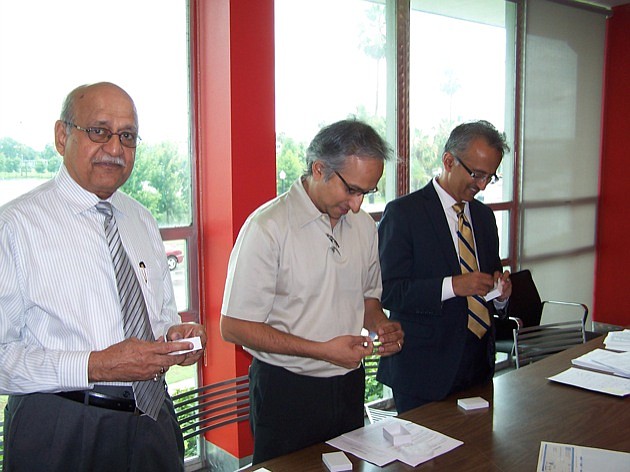REVIEW SUMMARY
Industry. Engineering and construction
Issue. Mergers and acquisitions
Key. Joining forces for the sake of growth, not survival, after the recession
Engineering firms have had to endure the downturn as much as any industrial segment. In some cases, firms have had to consolidate for survival, while in others, the opportunity has presented itself to combine disciplines and expand territory.
The latter was the case with ASC Geosciences Inc. agreeing in late June to join the Tampa office of Maryland-based KCI Technologies Inc. ASC's three offices and laboratories in Lakeland, Lake City and Fort Myers will be rebranded as KCI facilities.
KCI, which originated as Kidde Consultants Inc. in the 1970s, offers environmental, transportation, telecommunications, construction, facilities and land development services to government, institutional and private-sector clients. The one area it lacked was geotechnical, geo-environmental and forensic engineering, which is where ASC comes in.
Both firms have worked together for the last several years on various projects for Sprint Nextel and TECO Energy. During that time, they began talking about combining resources.
“We like the way they work and vice versa,” says Nathan Beil, president of KCI in Sparks, Md. “They bring us a discipline that we didn't have.”
In return, he says ASC will benefit from KCI's multi-disciplinary and geographic reach. The privately held company, which posted $131 million in revenue last year, has at least 20 offices throughout the Southeast, Northeast and Mid-Atlantic with 850 employees. It is ranked 83rd on Engineering News-Record's most recent list of the top 500 firms.
In comparison, ASC has 21 employees who will join KCI and posted $3.3 million revenue in 2009. The firm was established in 1984 by Dhirendra “Sax” Saxena, who originally moved to Central Florida in the 1960s to perform soil drilling for a California engineering firm on a top-secret development later revealed as Walt Disney World.
Anu Saxena, ASC's president and son of the founder, will become a vice president with KCI as well as a regional practice leader for the company, specializing in geotechnical engineering. The younger Saxena joined ASC a few years after getting his master's degree in civil engineering from Cornell University in 1988, and has broad experience in geotechnical engineering and testing, as well as forensic engineering and litigation support.
Sax Saxena, who had been CEO of ASC, has been named corporate practice leader of KCI's newly formed forensic engineering practice.
“Their culture, work ethic and principals are top drawer,” Beil says. He adds that the acquisition of ASC, for which terms are being kept confidential, positions KCI for an eventual economic recovery.
Benefits for both sides
While each firm has been adversely affected by the recession, he says the merger is beneficial to both.
“Their addition allows us to offer geotechnical and materials testing services and supplement our existing construction inspection work force while extending our geographic reach,” Beil says. “Their clients will benefit from the multi-discipline service offerings of KCI, while our clients will have access to local expertise not previously available through the firm.”
The merger between ASC and KCI could be a sign of things to come as the engineering field awaits the rebound.
Merger activity in the global engineering and construction sector was off to a fast start through this year's first quarter, with transaction values totaling $21.2 billion, according to an engineering growth report by PricewaterhouseCoopers. That figure is in stark contrast to the first three months of 2009, when only $2.6 billion in deals were recorded, but much closer to the $23.7 billion posted in the last quarter of last year.
“Looking ahead, we believe fundamentals are ripe for the (engineering and construction) deal environment to continue to improve,” the report stated. “In many global markets, credit is loosening, equity markets are advancing and economic growth rates are stabilizing.”
PricewaterhouseCoopers noted a strong rebound in mega-deals through the first quarter of 2010, with four transactions of at least $1 billion announced, indicating increasing optimism among financial and strategic buyers. No deals were announced in the same quarter a year earlier, and only seven happened throughout 2009.
Rainy day buying
PricewaterhouseCoopers observed that engineering firms may be able to gain leverage on competitors through deal making, with companies having strong balance sheets and robust cash reserves being in the best position for strategic mergers and acquisitions.
“Those who have built their balance sheets for a rainy day might come out of last year's storm to find the rainbow, and at the end of it, nicely valued acquisition targets,” Bob Filek, a partner with PwC's Transaction Services practice, stated in the report. “As a result, M&A activity in 2010 will be driven by strategic buyers who have access to capital and the strategic vision to capitalize on some of the best values we have seen in recent times.”
The report also advises that engineering and construction companies should consider the importance of due diligence after two years of economic contraction. Factors include new federal laws regarding health care and climate change, as well as commodity prices, pension plan structures, changing tax laws, company culture and the role of human resources.
KCI's Beil notes that in addition to consolidation among engineering firms, he has also noticed people leaving established companies to start their own. “The cost of entry for doing that right now is low,” he says.
Merge urge: An M&A checklist
PricewaterhouseCoopers offers the following questions for consideration in engineering firm mergers and acquisitions:
• How well does the target company support the company's corporate strategy?
• What cultural clashes might arise as the two companies come together?
• How competent is the target company's management? How easy will it be to work with?
• How skilled are the workers?
• Was revenue restated, and if so, why?
• Is the brand name listed as a major asset, and if so, who assessed its value?
• Is the company involved in litigation?
• Are there any inconsistencies in the numbers, such as artificially ramping up revenue at the end of the year by selling excess inventory at deep discounts to customers?
• Are there any warranties—written statements from the seller that confirm a key fact about the target's business?
• Are there any indemnities— commitments from the target company to reimburse the buyer in full in certain situations?
• What is the potential for product cannibalization?
• How effective is the target's anticorruption compliance program?
• Can the company mitigate its risk through deal structuring and/or contractual protection?
• Does the buyout or merger plan spell out offshore sourcing issues?
• If a massive system upgrade is planned, will the legacy systems run parallel until the new system is running smoothly? Are the risks of the technology expenditures clearly laid out and thought through?
• Does one of the merged companies have products with a quality or reputation that can harm the reputation or perceived value of products offered by the other merged company?
• Will there be overlapping sales territories, which can cause turf battles between sales representatives?






